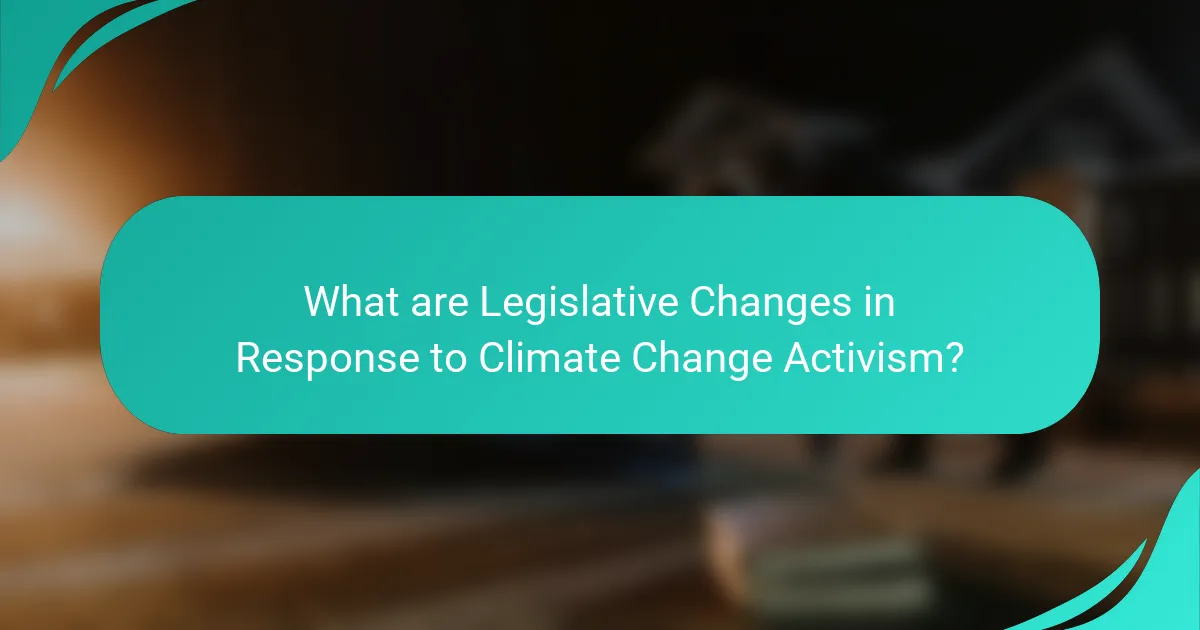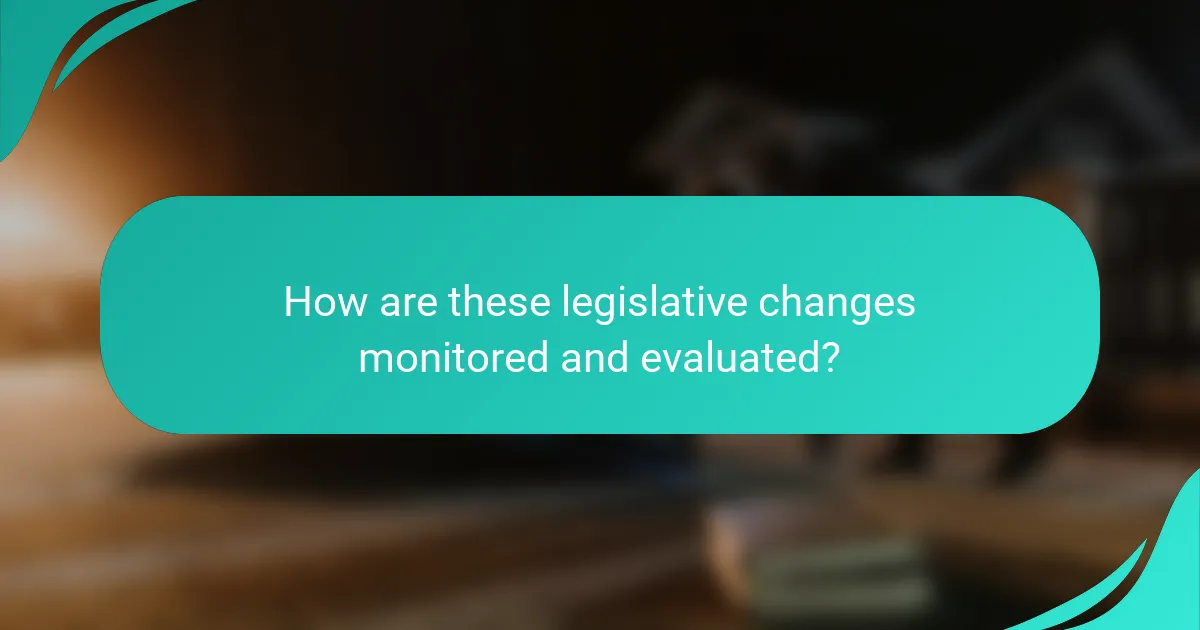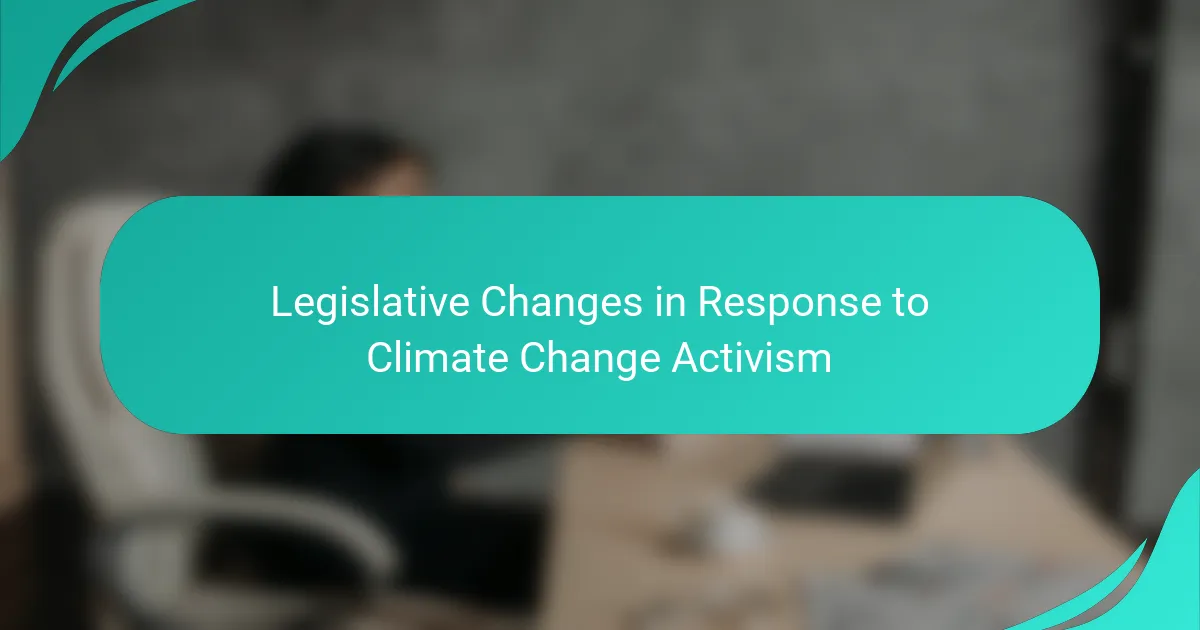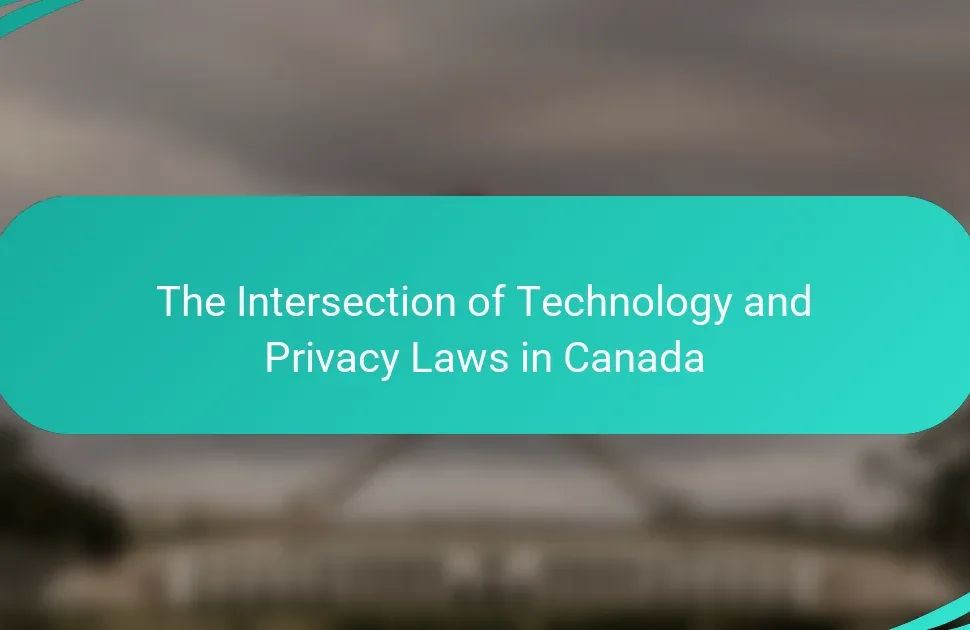
What are Legislative Changes in Response to Climate Change Activism?
Legislative changes in response to climate change activism include various laws and policies aimed at addressing environmental concerns. Governments worldwide are implementing stricter emissions regulations. These laws often arise from public pressure and activism advocating for climate action. For example, the European Union has set a target to become carbon neutral by 2050. In the United States, states like California have enacted ambitious climate goals. Additionally, many countries are committing to net-zero emissions by specific deadlines. These legislative changes reflect a growing recognition of climate issues. Activism has played a crucial role in shaping these policies and pushing for accountability.
How have recent legislative changes been influenced by climate change activism?
Recent legislative changes have been significantly influenced by climate change activism. Activist movements have raised public awareness about environmental issues. This increased awareness has pressured lawmakers to prioritize climate policies. In 2021, the U.S. Congress proposed the Build Back Better Act, focusing on renewable energy and emissions reduction. Activist groups played a crucial role in mobilizing public support for such initiatives. Additionally, international climate agreements, like the Paris Agreement, have prompted national legislation. Countries are responding to activism by implementing stricter regulations on carbon emissions. These trends demonstrate the direct impact of climate change activism on legislative frameworks.
What specific events have triggered these legislative changes?
Specific events triggering legislative changes include major climate summits and natural disasters. The Paris Agreement in 2015 led to commitments from countries to reduce greenhouse gas emissions. In 2019, youth climate strikes, inspired by Greta Thunberg, galvanized public support for stronger climate policies. The Australian bushfires in 2019-2020 highlighted the urgency of climate action, prompting legislative responses. Additionally, the COVID-19 pandemic shifted focus on sustainable recovery plans, influencing legislative agendas. Each of these events created a sense of urgency, leading to significant policy reforms aimed at addressing climate change.
How do public protests impact legislative decision-making?
Public protests significantly influence legislative decision-making. They raise awareness about specific issues and mobilize public opinion. Lawmakers often respond to the intensity and visibility of protests. For instance, protests can lead to increased media coverage, which pressures legislators to act. Historical examples include the civil rights movement, which resulted in landmark legislation. Additionally, studies show that public demonstrations can correlate with legislative changes. According to research by the American Political Science Review, protests can shift the political landscape in favor of certain policies. This demonstrates that public protests serve as a catalyst for legislative action.
What are the key objectives of these legislative changes?
The key objectives of these legislative changes are to enhance environmental protection and promote sustainability. These changes aim to reduce greenhouse gas emissions through stricter regulations. They also seek to increase funding for renewable energy projects. Another objective is to improve public awareness of climate issues. The legislation often includes provisions for greater accountability among corporations. Additionally, it aims to support communities affected by climate change. These objectives align with international climate agreements and national commitments to combat global warming.
How do these objectives align with climate change goals?
The objectives of legislative changes in response to climate change activism align with climate change goals by promoting sustainability and reducing greenhouse gas emissions. These objectives aim to create policies that support renewable energy, enhance energy efficiency, and protect natural resources. For example, many legislative efforts focus on transitioning to clean energy sources such as solar and wind. This shift is essential for achieving international climate agreements like the Paris Accord, which seeks to limit global warming to below 2 degrees Celsius. Additionally, these objectives often include measures for carbon pricing, which incentivizes businesses to reduce their carbon footprint. Research shows that countries implementing such policies have seen a measurable decrease in emissions. Therefore, legislative changes directly contribute to the overarching goals of mitigating climate change impacts.
What role do stakeholders play in shaping these objectives?
Stakeholders significantly influence the shaping of legislative objectives related to climate change. Their involvement ranges from providing input during policy formulation to advocating for specific changes. Stakeholders include government agencies, non-governmental organizations, businesses, and the public. Each group brings unique perspectives and expertise to the discussion. For example, environmental organizations often push for stricter regulations. Businesses may advocate for policies that balance economic growth with environmental protection. Public opinion can sway legislators to prioritize climate initiatives. Research indicates that stakeholder engagement leads to more effective and inclusive policies. A study by the World Resources Institute highlights that collaborative approaches improve policy outcomes.

What types of legislative changes have emerged?
Legislative changes in response to climate change activism include carbon pricing, renewable energy mandates, and emissions reduction targets. Carbon pricing mechanisms, such as cap-and-trade systems, have been adopted in various regions. These systems aim to limit greenhouse gas emissions by assigning a cost to carbon output. Renewable energy mandates require utilities to source a certain percentage of their energy from renewable sources. Many states and countries have set ambitious emissions reduction targets aligned with international agreements. For example, the European Union aims to achieve carbon neutrality by 2050. Additionally, legislation has emerged to enhance climate resilience and adaptation strategies. These changes reflect a growing recognition of the urgency of climate action driven by public demand and activism.
How do regulations differ across various regions?
Regulations differ across various regions based on local laws, environmental policies, and political climates. For instance, the European Union has stringent emissions regulations aimed at reducing carbon footprints. In contrast, the United States has a more fragmented regulatory landscape, with states like California implementing stricter standards than federal regulations. Asia presents a mixed approach, with countries like Japan focusing on renewable energy while others may prioritize economic growth over environmental concerns. These variations often reflect cultural values, economic priorities, and levels of public engagement in climate issues. Historical context also plays a role; regions with a history of environmental activism tend to adopt more progressive regulations.
What are examples of successful legislative changes in different countries?
Germany implemented the Renewable Energy Sources Act in 2000. This law significantly increased the share of renewable energy in the country’s power supply. By 2020, renewables accounted for about 42% of electricity generation in Germany.
New Zealand passed the Zero Carbon Act in 2019. This legislation aims to reduce greenhouse gas emissions to net zero by 2050. It also establishes a framework for climate action and accountability.
The United Kingdom introduced the Climate Change Act in 2008. This was the world’s first legally binding national commitment to reduce greenhouse gas emissions. The UK government set a target to cut emissions by at least 80% by 2050 compared to 1990 levels.
France adopted the Energy Transition for Green Growth Act in 2015. This law aims to reduce fossil fuel consumption and promote renewable energy. It sets a goal of reducing greenhouse gas emissions by 40% by 2030.
Canada’s federal government enacted the Canadian Net-Zero Emissions Accountability Act in 2021. This law commits Canada to achieving net-zero emissions by 2050. It establishes accountability measures for the government to meet its climate targets.
How do local versus national laws address climate change activism?
Local laws often provide specific regulations that support climate change activism, such as permitting protests or creating local climate action plans. National laws, on the other hand, tend to set broader frameworks for climate policy and can influence local legislation. For example, national policies like the Clean Air Act establish standards that local governments must follow. Local laws can be more responsive to community needs and activism, allowing for quicker adaptations to environmental concerns. In contrast, national laws may take longer to enact due to the legislative process. Additionally, local governments can implement more stringent measures than national laws require, reflecting the priorities of their constituents. This dual approach allows for a combination of grassroots activism and broader policy initiatives to address climate change effectively.
What are the implications of these legislative changes?
The implications of these legislative changes include enhanced regulatory frameworks for environmental protection. These changes often lead to stricter emissions standards for industries. Companies may face increased compliance costs as a result. Additionally, there could be a shift toward renewable energy sources mandated by law. This transition aims to reduce carbon footprints significantly. Job creation in green technologies may also occur due to these new regulations. Public awareness and engagement in climate issues are likely to increase. Overall, these legislative changes aim to mitigate climate change impacts effectively.
How do these changes affect businesses and industries?
Legislative changes in response to climate change activism significantly impact businesses and industries. These alterations often lead to stricter regulations on emissions and waste management. Companies may face increased operational costs due to compliance with new environmental standards. Additionally, industries reliant on fossil fuels may experience a decline in demand as renewable energy becomes prioritized.
Investments in green technologies are likely to rise, altering market dynamics. For instance, the International Energy Agency reported a 50% increase in renewable energy investments in 2021. Companies that adapt quickly may gain competitive advantages. Conversely, those that resist change could face penalties or lose market share. Overall, legislative changes compel businesses to innovate or risk obsolescence.
What are the potential legal challenges to these new laws?
Potential legal challenges to new climate change laws include constitutional issues, regulatory compliance, and enforcement difficulties. Constitutional challenges may arise if laws infringe on rights or exceed government authority. Regulatory compliance issues may occur if new laws conflict with existing regulations or require extensive changes. Enforcement difficulties can stem from insufficient resources or public opposition. Historical cases, such as Massachusetts v. EPA, illustrate how legal challenges can shape environmental regulations. Additionally, the vagueness of certain provisions may invite lawsuits from affected parties seeking clarification or relief.

How are these legislative changes monitored and evaluated?
Legislative changes in response to climate change activism are monitored and evaluated through systematic assessments. These assessments often involve tracking compliance with new laws and regulations. Government agencies typically collect data on environmental outcomes related to these legislative changes. Public feedback and stakeholder consultations also play a vital role in evaluation. Reports on the effectiveness of legislation are frequently published to inform the public and policymakers. Additionally, independent research organizations may conduct studies to evaluate the impact of these laws. For instance, the Environmental Protection Agency publishes annual reports detailing progress on climate-related legislation. This comprehensive approach ensures that legislative changes are effectively monitored and evaluated for their intended impact.
What metrics are used to assess the effectiveness of these laws?
Metrics used to assess the effectiveness of climate change laws include emissions reduction targets, compliance rates, and economic impacts. Emissions reduction targets measure the decrease in greenhouse gas emissions over time. Compliance rates indicate how well organizations and governments adhere to the laws. Economic impacts assess the financial implications of the laws on industries and communities. These metrics provide a comprehensive view of the laws’ effectiveness in addressing climate change.
How do advocacy groups contribute to monitoring efforts?
Advocacy groups contribute to monitoring efforts by collecting data on environmental policies and practices. They analyze the effectiveness of legislation aimed at combating climate change. These groups often publish reports that highlight gaps in compliance and enforcement. They mobilize community members to participate in data collection activities. Advocacy groups also engage in public awareness campaigns to educate citizens about climate issues. They collaborate with researchers to ensure accurate information is utilized in monitoring efforts. Additionally, they lobby for transparency in governmental reporting on climate initiatives. This collective action enhances accountability and drives legislative changes.
What role does public opinion play in evaluating legislative success?
Public opinion significantly influences the evaluation of legislative success. It shapes policymakers’ perceptions of public needs and priorities. Legislators often consider public sentiment when proposing or supporting legislation. High public support can lead to quicker legislative action. Conversely, negative public opinion may stall or defeat proposed measures. For example, legislation addressing climate change has seen varying levels of success based on public awareness and concern. Research shows that when public opinion strongly favors climate action, legislative bodies are more likely to respond effectively. Therefore, public opinion serves as a critical barometer for legislative effectiveness and prioritization.
What best practices can be adopted for future legislative efforts?
Future legislative efforts should prioritize stakeholder engagement. Involving diverse groups ensures that various perspectives are considered. This approach leads to more comprehensive and effective legislation. Evidence shows that inclusive processes yield better policy outcomes. Additionally, data-driven decision-making is essential. Utilizing scientific research and statistics can guide effective legislation. For instance, legislation based on climate models can address specific environmental issues. Furthermore, transparency in the legislative process builds public trust. When citizens understand the decision-making process, they are more likely to support initiatives. Lastly, regular reviews and updates of legislation are crucial. This practice allows laws to adapt to new information and changing circumstances. Studies indicate that adaptive legislation is more resilient and effective in the long term.
How can collaboration between activists and lawmakers improve outcomes?
Collaboration between activists and lawmakers can significantly improve outcomes by aligning policy goals with public advocacy. Activists provide grassroots insights that inform lawmakers about community needs and priorities. This collaboration can lead to more effective and targeted legislation. For example, the Green New Deal emerged from strong activist support, emphasizing renewable energy and climate justice. Research shows that when lawmakers engage with activists, they can draft legislation that reflects the urgent demands of the public. This synergy fosters accountability and ensures that policies are not only enacted but also supported by the community.
What strategies can ensure sustained public engagement in climate legislation?
Effective strategies for sustained public engagement in climate legislation include education, transparency, and community involvement. Education empowers citizens with knowledge about climate issues and legislative processes. Research shows that informed individuals are more likely to participate in advocacy efforts. Transparency in governmental actions fosters trust and encourages public dialogue. Studies indicate that when people feel included, they are more likely to engage with legislation. Community involvement through local initiatives can create a sense of ownership over climate policies. Engaging local leaders can amplify voices and drive grassroots movements. Regular updates and feedback mechanisms keep the community informed and involved. Data from successful campaigns demonstrate that these strategies can lead to increased public participation and support for climate legislation.
Legislative changes in response to climate change activism encompass various laws and policies aimed at addressing environmental concerns, driven by public pressure and activist movements. Key topics include the influence of activism on recent legislative reforms, specific events that triggered these changes, and the objectives behind new regulations, such as enhancing environmental protection and promoting sustainability. The article also examines the role of stakeholders, the differences in regulations across regions, successful legislative examples, and the implications for businesses and industries. Finally, it discusses monitoring efforts, the impact of public opinion, best practices for future legislation, and strategies for sustained public engagement.




